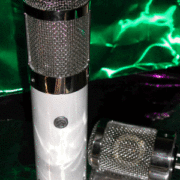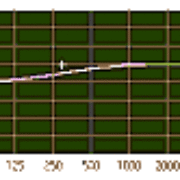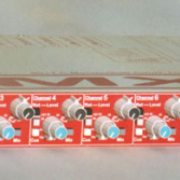PLEASE NOTE: This article has been archived. It first appeared on ProRec.com in September 1998, contributed by then Editor-in-Chief Rip Rowan. We will not be making any updates to the article. Please visit the home page for our latest content. Thank you!
DirectX Moves into the Future
A new war is proceeding on your desktop. And you might not even know it.
For those of us already living in the future, DAW recording is here to stay. We are searching for more and more power within the computer, and – by and large – we’re finding it.
I’m still back in the safe waters. I haven’t upgraded my computer in over two years. I use an industry-standard Digital Audio Labs Card D+ 2 in / 2 out soundcard for recording. And I have opted to wait until my simple, safe DAW software supports 24 bits rather than running right out and buying the first package that says “24 bit compatible!” on the box. I’ll let someone else learn all the hard lessons, thank you very much.
Out on the bleeding edge of DAW recording are guys that have overclocked Celerons and Pentiums, running redundant RAID systems, with lots of RAM and big lightpipe-based audio recording devices like the Frontier Tango.
One thing is clear: if the computer’s going to do all the work, we need a lot of computer.
A good sounding reverb algorithm, like the DSP-FX reverb or the Sonic Timeworks 4080L requires a LOT of processing power in order to perform live in real-time. Dynamics processors (compressors, limiters, gates, expanders) and EQs don’t require as much power, until you start getting fancy (gate into compressor into EQ into de-esser). And of course we want to run EQs and compressors / limiters / gates on EVERY channel. Just like the big boys.
So what DOES it take to get a 32-track hard disk playback with compressors and EQs on every channel, a couple of good-sounding reverbs, and some cool special effects (vocoders, tremelos, what have you)?
Some of the people on the bleeding edge are almost there. I suspect that next year’s state-of-the-art hardware will be able to pull it off.
Others are already there. Some have been there for years.
Take ProTools. Obviously the folks with ProTools workstations have had a healthy supply of mixing power for a few years now. Get a decent Mac, buy ProTools, throw in a few DSP farms, load up Studio Vision, and you’re there baby.
Or take the Digital Audio Labs V8. This was the first “workstation” solution to arrive on the PC. Same solution: buy the controller interface, throw in a bunch of DSPs, get a compatible software recorder like MxTrax, and jam on.
Both of these are quite expensive, however, compared with the solutions you’ll find running around here in the More-For-Less Club. Pro Tools and V8 cost big bucks! You’re taking a big risk with these solutions:
- You are buying into a proprietary format, and
- You’re going to invest a lot of money.
Taken together, these are serious problems.
Item (1) suggests that, should an open standard become available, the vendor you chose (ProTools) suddenly may face competition from extreme market segmentation. Item (2) suggests that when that happens, you’re screwed, because you sunk big bucks into the proprietary solution which is suddenly virtually worthless. Go to rec.music.makers.marketplace and see what I mean.
There’s an experience in another industry that I think perfectly illustrates the dilemma:
About 12 years ago, Apple introduced something that made their Macintosh computer really useful. It was called the LaserWriter printer, and was the first PostScript printer to hit the consumer market.
The original LaserWriter was slow – it took forever to process a page – and low-resolution by today’s standards (300 dpi) and therefore didn’t attract much professional attention. The BIG BOYS in the publishing business were using Linotypes and Wangs and couldn’t see how this little toy computer and this slow, but cool, little personal printer could possibly affect their business.
What PostScript meant was simple: any software that uses PostScript can print with the highest available quality on any printer that supports PostScript, regardless of the resolution or format of that printer. The problem of how to get my software to talk to your printer just magically vanished.
Linotype eventually saw that the Macintosh was a pretty neat computer, so they ported their software to it. One computer would be for the writer, another for the editor, another for the layout artist, etc. etc. etc.. Their high-volume printers didn’t support PostScript, but rather a proprietary printing format. What they did was pave the cowpath. They didn’t try to use the new technology to change the way they worked, they fit the new technology into the way they had always worked.
Meanwhile, this open standard called PostScript started attracting more and more attention. Xerox figured out a way to include it in their high-volume copier / printers. We started getting film-output devices that could print to film at exceedingly high resolution. The software was vastly and quickly improved. And the publishing business was forever changed. PostScript is the basis for most of what you see in print today, from billboards to magazines to the logo on your favorite T-shirt.
What is the relevance of this vastly entertaining but somewhat tangential anecdote?
Simple. In 1987 it would have been ludicrous to try to solve the world’s publishing problems with PostScript. In 1997, it was ludicrous to try to solve the world’s publishing problems WITHOUT PostScript. And if you look at what happened to the little guys in 1987 over the next ten years, well, Kinko’s and AlphaGraphics and Creative Type and Graphics are all doing pretty well, thank you very much. And the big boys reinvented themselves around PostScript or they perished.
Lesson Learned: when the market adopts an open standard and learns to cooperate, the proprietary solution faces competition from extreme market segmentation. Linotype had to write the software, build the printers, integrate the pieces, and support all the changes themselves. Meanwhile in the PostScript world, Xerox built the printers. Quark wrote the software. 3Com made the networks. Ad infinitum.
The user had CHOICES. The user had FLEXIBILITY. The user wasn’t locked into ONE vendor. And individual pieces could be replaced without replacing the WHOLE system.
And thus we come full-circle. It is 1998, and in the DAW recording world there is a new problem to be solved: processing lots of audio through the computer.
The open standard is here. It’s called DirectX and lots of companies are supporting it. It is rapidly gaining attention because it allows any company to write software for it, and it’s compatible with all PC hardware and any PC DAW software. Instant market, just add open standard. DirectX runs on the computer’s processor.
Some companies are betting on this open-standards solution. For example, the unreleased Gadget Labs Wave/824 is a 24-bit converter system with a pro breakout box, for a low price and no DSPs. And DSP-free lightpipe solutions abound for getting audio into and out of a computer.
However, not EVERYBODY has a processor capable of supporting 24 DirectX EQs and 24 DirectX compressors and three 32-bit reverbs and a flanger and two choruses and two delays. And – maybe we want all that and more!
Enter the proprietary solutions. Can’t wait for a faster CPU to run DirectX? Buy the Yamaha DSP Factory! Or Creamware’s Pulsar! Or the Digital Audio Labs V8! Or ProTools!
What these companies are doing is gaining short-term advantages at the cost of long-term viability. What, you say you don’t want to buy any more little rackmount boxes to process reverbs? Ok, we’ll take the reverb DSP and put it on a computer card, and you can control it with your computer instead of the rack box, how’s that? It’s still a DSP that does reverb. You have to run specific software (open market software like DirectX won’t run on a DSP). You don’t benefit from the open market for such software (when company XYZ writes a new, cool reverb that’s better than yours, you’re outta luck!), and you don’t advance at the speed of the market, but rather at the speed of the vendor you chose. You’re locked in, baby.
Meanwhile, the folks over at Intel and AMD and Cyrix are making faster and faster processors. We already have processors that can ALMOST give us more 32-bit audio processing than we need. In a year or two, we’ll be drowing in audio processing power.
For the cost of an average-price DSP solution, most of us could upgrade our motherboards to the latest and greatest model. And still have money to spend on a new DirectX FX package.
So if you’re one of the people in the business that has to have it all – and has to have it now – then the upcoming wave of DSP solutions is for you. Be prepared to spend some dough. And be prepared to be passed by your peers in a few years. And – be prepared to be blown away – because some of the new DSP systems are AWESOME!
If you’re like me – and you would rather dump $3000 into a new mic and preamp, not a new soundcard, then just keep waiting. The market knows what we want. Maybe it will get there sooner than we think….



